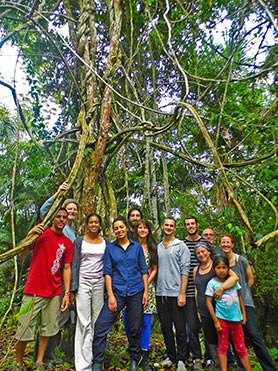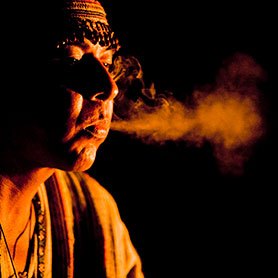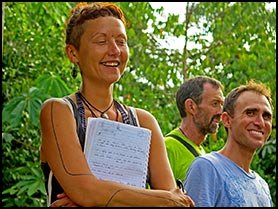
Medicinal Plant Directory
Plant medicine is older than history, older than humankind itself, for undoubtedly animals were using plants to heal before humans emerged on earth. We, as living beings, are all made of the same planetary material and we use this material, our own and of others, to live together, making up the body of Mother Earth. We share the air we breath with the plants, in a beautiful example of how interconnected we are. Where would we be without plants?
This directory is our way of helping to preserve the wisdom of plant medicine. It will forever be in development, as we continue to learn and discover more information regarding the medicinal properties, chemistry, and preparation of a growing number of plants.
Achiote – bixa orellana

Ajo Sacha – mansoa alliacea

Ajo sacha is well used and respected by most of the indigenous Indian tribes of the Amazon and almost all parts of the plant are used; the leaves, vine bark, and root. Most consider the plant to be magical and capable of driving away dark spirits. Sometimes, it is used as an ingredient in the making of ayahuasca. It is most often used in baths, however, to cleanse the spirit from negative energy and to boost the immune system and the body’s ability to resist colds and illnesses.
It can be used to treat inflammations, rheumatism, arthritis, colds, uterine disorders, and epilepsy. The root is prepared in a cane alcohol tincture as an overall regenerative tonic. Dieting with this plant can often produce a heightened sense of brain activity and the ability to focus and concentrate, which is very helpful when drinking ayahuasca, and in life in general.
Albahaca – Ocimum basilicum

It is often used for digestive problems, to prevent gastric spasms, and is very useful in the cases of the gastritis, hiatal hernia, and flatulence. The aroma of the plant stimulates the appetite, reduces nausea, and can also stimulate the production of milk in nursing mothers. It strengthens the nervous system, treats mouth ulcers and bad breath, and can even be used in abdominal massages. A seed of albahaca placed in the eye will remove unwanted material from the eye, like mucus.
Albahaca is often used in conjunction with other plants. One popular remedy is to combine five leaves of albahaca, three leaves of malva, and one large leaf of salvia and brew a tea. This will calm the symptoms of indigestion, gastritis, and even reduce an inflamed prostate. It is often used in the treatment of prostate cancer.
Anis – pimpinela anisum

Anise is used to treat digestive and stomach problems like gastritis, stomach aches, heartburn, and flatulence. It is also used as a remedy for asthma, respiratory diseases, bad breath, and to increase one’s appetite. For this reason, it is also used in treatment for eating disorders like anorexia. Anise can also ease nervous anxiety, help colds and coughs, bronchitis, and aid with tonsillitis.
Ayahuasca - Banisteriopsis Caapi

There are several different types of Ayahuasca vines, each with different chemical compositions. The most popular variety to use in the healing brew is ‘Cielo Ayahuasca’ because it is considered to be the smoothest and easiest on the head. Some of the other varieties are ‘Boa,’ ‘Rayo,’ and ‘Negra.’
The vine has brown bark, usually covered by moss, that twists in a spiral as it grows, with green offshoots and ovate-lanaceolate leaves up to 8 inches long and 3 inches wide. The vine rarely produces flowers or seeds, going several years without blooming. The flowers are pink, with five delicate, fringed edged petals, and bright yellow, bizarre pistols, that seem to resemble some sort of alien cat. The seeds come individually inside a winged shell that ‘flies’ away.
Ayahuma – Couroupita guianensis

The flowers, leaves, bark and fruit flesh are used medicinally. Ayahuma possesses antibiotic, antifungal, antiseptic and analgesic qualities. The bark is used to cure colds and stomach aches. The juice made from the leaves is used to cure skin diseases and for treating malaria. The inside of the fruit can disinfect wounds and young leaves ease toothache. It is common for curanderos to diet with this powerful tree in order to strengthen their spirits and protect them from dark or negative entities.
Bobinsana – Calliandra angustifolia

Bobinsana is used for several reasons, most commonly as a stimulant and to treat arthritis and colds. The roots are often used in plant diets to give strength and energy and the bark is sometimes added to plant baths to boost the immune system and to increase resistance to sickness.
Considered a plant teacher in the tradition of curanderismo, bobinsana is occasionally added to ayahuasca preparations but it is more commonly dieted on its own in order to learn more about its healing properties and to gain power through connecting with its spirit. It has been used to treat a number of illnesses due to its immune system boosting properties.
Capirona – Calycophyllum spruceanum

Capirona bark is used as an admixture to ayahuasca, but it is more often used as a poultice made from the bark to treat cuts, wounds and burns. It is believed to have antifungal and wound-healing qualities. A tea made from the bark is used as a lotion after bathing. This forms a thin film covering their bodies believed to help fight the effects of aging, parasites and fungal infections. A bark decoction is also used to treat diabetes. 1kg of the bark is boiled in 10 liters of water until 4 liters remain. It is believed that if this decoction is drunk every day (about 5 ounces daily) for three consecutive months that it is a “cure” for diabetes. Peruvian tribes also apply the powdered bark to fungal infections of the skin. They also prepare a bark decoction to treat skin parasites – especially “sarna negra” – a nasty little bug that lives under the skin which is commonly found in the Amazon basin area.
A bark decoction is used topically for eye infections and infected wounds as well as for skin spots, skin depigmentation, wrinkles and scars. It also stops bleeding quickly and is often applied to bleeding cuts and to soothe insect bites and reduce bruising and swelling. The resin is used for abscesses, and skin tumors.
Catahua – Hura crepitans

Most commonly used in vapor baths, the bark of the Catahua plant provides protection from negative spirits by producing a suit of armor similar to its bark in the spiritual dimensions. The thorns are carefully cut off the bark prior to using it, however, to prevent any toxins from being inhaled during the vapor baths. It is also a powerful teacher plant and is often dieted along with ayahuma or by itself, using a decoction made from boiling the bark.
Chacruna – psychotria viridis

Because of its chemical composition, the mixture of plants allows the shaman to enter a spiritual dimension where most of shamanic work takes place. The brew is drunk in healing ceremonies lead by ‘curanderos’, or shamans that heal.
There are several different varieties referred to as Chacruna by the shamans of the Amazon, but psychotria viridis is the most common of them all.
The shiny leaves of this evergreen bush are long and narrow and vary from bright to dark green. The small white flowers grow on long stalks that produce several red berries, about 1cm in length. These berries contain multiple long, oval seeds.
Chanca Piedra – phyllanthus niruri

Chanca piedra is also used to treat hepatitis, tuberculosis, and other viral infections, as well as for liver conditions and venereal diseases. The entire plant, including its roots, is used when making the preparation. It is one of the most famous medicinal plants in the Amazon for its incredible ability to remove stones, but also for its positive effect on general health, digestion, and cellular activity.
Chiric Sanango – brunfelsia grandiflora

The root of Chiric Sanango is said to stimulate the lymphatic system, and it has also been used for the treatment of syphilis. It is powerful teacher plant as well and is commonly dieted to increase energy, healing awareness, and to boost the immune system. It is very common for it to be found near the homes of curanderos as well as throughout the gardens of people everywhere, as it is always in bloom and its purple flowers are beautiful.
Chuchuhuasi – maytenus macrocarpa

The medicinal bark decoction is often used as a general tonic to help indigenous older people on long walks or when working in their farms or chakras. The reddish bark is soaked in sugar can rum and can be kept for long periods of time without losing its medicinal properties.
Copaiba – Copaifera officinalis

Copaiba resin is used topically to treat cuts and wounds and to stop bleeding. It is also used in the treatment of skin sores and skin conditions like psoriasis. It can be taken internally in very small doses for the treatment of respiratory problems like bronchitis and to treat kidney and bladder infections. It is sometimes used to help with ulcers and incontinence. It is primarily used topically for treating skin problems, even being employed to help with insect bites.
Guanabana – Annona Muricata

Hierba Luisa – cymbopogon citratus

It is sometimes used as a purgative, where a weak tea is drunk in very large quantity to induce vomit at the end of a plant diet or to help with digestion. It has a very nice flavor and smell and helps with maintaining general health when used regularly.
Huacapurana – campsiandra angustifolia

A decoction made of the bark taken from the corona of the tree is used in small doses as a severe purgative and treatment for cancer and blood born illnesses. This treatment produces profound vomiting and diarrhea but is often used by curanderos to increase their spiritual strength and connection to the spirit world. After drinking, the following ayahuasca ceremonies are often much easier to navigate with much stronger visions.
Ishanga – urtica dioica

Ishanga is used against a variety of complaints such as muscular and arthritis pain, eczema, ulcers, asthma, diabetes, intestinal inflammation, nosebleeds and rheumatism. Externally it is used for inflammations, sciatica, wounds and head lice.
The stinging sensation of the leaf hairs is caused by several plant chemicals including formic acid, histamine, serotonin, and choline. Several of Ishanga’s lectin chemicals have demonstrated marked antiviral actions (against HIV and several common upper respiratory viruses). Other chemicals (flavonoids in the leaves and a lectin in the root) might be useful in the treatment of systemic lupus.
Maca – lepidum meyenii

Rich in nutritional content (potassium, and higher levels of calcium than in milk), maca is a natural hormonal balancer which provides great health benefits for both, men and women. Due to its high nutritional value, maca is not only popular as a sexual libido enhancer and menopause symptoms savior, but also greatly affects energy, stamina, depression, and memory.
In Peruvian herbal medicine today, maca is reported to be used as an immunostimulant; for anemia, tuberculosis, menstrual disorders, menopause symptoms, stomach cancer, sterility (and other reproductive and sexual disorders), to enhance memory, to increase energy, stamina, and endurance, to promote mental clarity, and to help with menstrual irregularities, female hormonal imbalances, menopause, and chronic fatigue syndrome.
Malva – malachra ruderalis

As a poultice, mallow leaves will draw out boils and pus from old infections. Rashes and burns can be successfully treated with mallow leaves, crushed or blended. Mallow mucilage is also used to treat acne. The morning after an ayahuasca ceremony, It was normal and encouraged to drink the cold water mucilage drink in order to cleanse the digestive system from any toxins left over from the previous night’s purge.
Mapacho – nicotiana rustica

The principal active biochemicals are nicotine, nornicotine and anabasine. The proportion of each varies greatly among the species and varieties. As many as eight other pyridine alkaloids occur in lower concentrations.
A perenial shrub characterized by large fleshy leaves and numerous sticky hairs, Tobacco is smoked on rare occasions, except in ceremonies and curative rituals of the medicine men who blow smoke over the patient or inhale the smoke, all with appropriate incantations and ritual. Recreational smoking amongst the Indians of the northwest Amazon is not common, and cigarettes are rarely smoked except in areas where tribal customs are breaking down due to acculturation and the availability of commercial cigarettes.
The mestizo ayahuasqueros of Perú use mapacho as an admixture to the sacred brew and usually smoke large cigarettes during ayahuasca ceremonies, both inhaling the smoke and also blowing the smoke over patients, a process called ‘soplaying.’
Ojé – ficus insipida

The latex is also used to rub onto rheumatic inflammations.
Paico – chenopodium ambrosioides

Indigenous people in the Amazon use it to expel intestinal worms and as a mild laxative. (usually by taking one cup of a leaf concoction each morning before eating for three consecutive days). The plant concoction is also used for stomach upsets and internal hemorrhages caused by falls, to expel intestinal gas, as an insecticide, and as a natural remedy for cramps, gout, hemorrhoids, and nervous disorders. Some indigenous tribes bathe in a concoction of Paico to treat childhood trauma or to reduce fever and will also throw a couple of freshly uprooted green plants onto their fires to drive mosquitoes and flies away.
Sacha Culantro – eryngium foetidum

While commonly used as a condiment with a distinctive flavor, the leaves are also used in a tea to treat indigestion, diarrhea, nausea, or dispel flatulence. Often used in conjunction with sage and/or mallow as well to maintain healthy digestion and immune system function.
Salvia – salvia officinalis

Sangre de Grado – Croton Lechleri

Sangre de Grado has been known and used as: anti-tumor, cicatrizant/anti-cancer, anti-diarrheal, anti-oxidant, anti-inflammatory, anti-bacterial, anti-viral, anti-fungal, wound healing. It demonstrated potent antibacterial activity against Bacillus subtilis, Escherichia coli, genital herpes lesions, excellent healing agent for wounds, blisters, and burns.
Tangarana – triplaris surinamensis

A bark infusion is used throughout the Amazon as a ‘cure all’ and to treat intenstinal infections and diarrhea. The juice of the bark is used to treat toothache. Also used as vermifuge and for the treatment of herpes. The thin, papery bark is delicately sliced off with a machete and boiled, taken twice daily for several months.
Toé – brugmansia suaveolens

Its confirmed medicinal qualities are spasmolytic, anti-asthmatic, anticholinergic, narcotic and anesthetic. The leaves are smoked to relieve asthma. A steambath is prepared from the leaves for bad coughs and bronchitis. The juice is boiled and mixed with lard as an external application for burns, scalds, inflammations and hemorrhoids. Poultices made of the leaves are applied to arthritic or rheumatic pains, swellings and badly healing wounds . It is used as an antispasmodic to control Parkinson’s disease.
In the Amazon, Brugmansia is used in magical practices for visionary journeys, shape-shifting, divination, clairvoyance, love magic, aphrodisiac, amulets, and incense. Scopolamine is responsible for the visionary effects and is the alkaloid occurring in highest concentration. Curanderos respect it as very powerful plant and use it cautiously and sparingly. On the other hand, Brujos, individuals engaged in the practice of black magic, may use Toé frequently with little discrimination or integrity in its applications.
Uña de Gato – uncaria tormentosa

Cat’s Claw is used to treat cancer, HIV, AIDS, urinary track infection & inflammations, arthritis, rheumatism, sciatic nerve spasm, ulcers, and tumors. It is a very potent immune system booster and studies indicate that cat’s claw has the ability to protect cancer cells from maturing.


